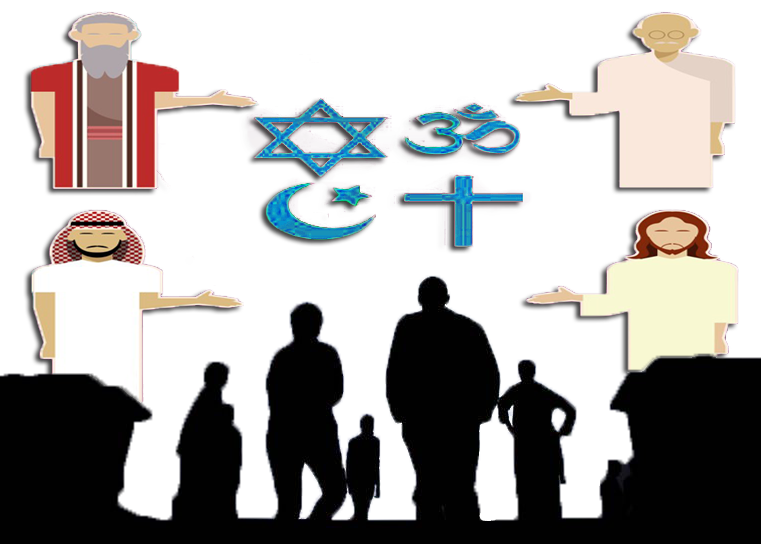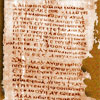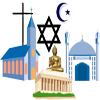The Problem Of Religion
 by Acharya S/D.M. Murdock
by Acharya S/D.M. Murdock
The reproaching cry of heretic, infidel, atheist, etc., will be raised against the author of these lectures, by every fiery intolerant bigot into whose hand they may fall. But he alone is the true infidel who forsakes the laws of his nature, and gives up his mind to a belief in fabulous and demoralizing legends, which contradict all experience, and stand in opposition to the testimony of his own sense and reason.” – Christian Mythology Unveiled, 1842
While the Western world begins its new millennium, little has changed in terms of religious understanding, and the world in general continues to be divided largely along the lines of faith. The proselytizers, proponents and propagandists of these various faiths persist in fighting over bodies and souls, in an endless religious tug-of-war that has ruined culture, wrecked minds and wreaked havoc. It also invades privacy and stomps all over individual rights. Religion is motivated by fear and insecurity: People want to believe, in God, Jesus, Krishna, Buddha—something, anything, so as not to feel so alone, helpless and forgotten.
Life is a cruel, sadistic torment in countless places around the globe. This fact should create more questions than it does about whether or not there is any good god in charge of everything and whether or not religion has any value in the first place. Yet, in the face of tragedy, rationality and logic fail to win out over powerlessness that desperately needs to believe in the Other, somewhere “out there.” What this insight reveals is that God is a popular concept not because people have reasoned it through and proved it true, but because humans are terrified of the opposite notion: If God is not, all is for naught.
The concepts of God and religion have varied greatly over the millennia, in the sense that they have been developed within cultural contexts, with odd details and interpretations based chiefly on race, gender, language and environment. Thus, goddess worship rather than god worship dominated in a variety of places globally for thousands of years, and gods and goddesses often have been of the same color and mentality, and speaking the same language, as the culture in which they are developed. These variances have led to a horrendous amount of suffering and terror, as fanatics of sundry religions, sects, cults, etc., have believed themselves superior to all the rest, and have attempted to force themselves upon everyone else. This aggressive behavior also is out of insecurity, as beliefs are flimsy things, and it is imagined that the more people who believe, the more these beliefs will be real. Not so, unless as a phantasmagoria, a nightmare….
The Intolerance of Religion
In this day and age, when the world becomes smaller than ever before, there is an increasing need for investigation and education in religion, as it is one of the most important and volatile of all human issues. Save for the few enlightened periods and places, throughout history people of faiths different from the ruling religion have been persecuted mercilessly. Oddly enough, the Roman Empire, which was notorious for hardship and horror, nevertheless exercised religious tolerance to an extreme degree; yet, cultures with the pretense of being more civilized than Rome terrorize and kill those who do not follow the prescribed path and preferred god. Thankfully, some nations have achieved a standard of not persecuting and prosecuting members of minority religions and non-religious freethinkers for “blasphemy” and “heresy.” However, in many countries freethinkers, secularists, agnostics and atheists remain pariahs and outcastes, even though many of the world’s greatest thinkers have been of this inclination.
Among the countless atrocities committed in the name of God and religion over the millennia looms large the practice of human sacrifice. This bloody and common ritual allowed for marauding Christian armies to justify the cultural destruction and genocide perpetrated in so many nations globally, including in the Americas, as a prime example. In other words, in order to stop human sacrifice, Christian armies sacrificed millions of humans. Moreover, the god of the Old Testament was hardly a paragon of peace and love, and the list of atrocities gleefully boasted about in the Bible is long indeed. As British royal physician Dr. Thomas Inman states in Ancient Faiths and Modern:
“…Is there any human king who ever promulgated a more bloody order than did Jehovah Sabaoth, the God which, amongst the Hebrews, corresponded to the Mexican god of war, when he commissioned Samuel to say to Saul (1 Sam. 15:3), ‘Now go and smite Amalek, and utterly destroy all that they have; slay both man and woman, infant and suckling, ox and sheep, camel and ass!’ After such a destruction of the Midianites as is narrated in Number 31, the fearful slaughter, effected by Crusaders, of Jews, Turks, and heretics, is scarcely worth mentioning.
“…and surely, when our Bible, which is treasured by so many as the only rule of faith amongst us, details such horrible religious slaughters as are to be found in its pages, and abounds with persecuting precepts, we had better not talk too much about Mexican sacrifice. Was there any Aztec minister so brutal in his religious fury as Samuel was (1 Sam. 15:33), who hewed Agag into pieces? The Mexican was merciful to his victim; the Hebrew was like a modern Chinese executioner, who kills the criminal by degrees….
“Surely the Christians have too much sin amongst themselves to cast a stone at the inhabitants of Mexico.
“We find a very strong offset to the horror of Aztec cruelty in the very Bible, which we regard as the mainstay of our religious world. What, for example, is the essential difference between a Mexican monarch sacrificing one or ten thousand men taken in battle, and Moses commanding the extermination of the inhabitants of Canaan, and only saving, out of Midian, thirty-two thousand virgins, that they might minister to the lust of Hebrew followers? What, again, are we to say of David’s God, who would not turn away from his anger from Judah until seven sons of the preceding king had been offered up as victims? And lastly–thought still more awful! what must we say of the fundamental doctrines of Christianity, that Jehovah Himself sacrificed His own Son by a cruel death; and not only so, but that He had intercourse with an earthly woman, and had thus a son by her, for the sole purpose of bringing about his murder?”
Furthermore, while there certainly was a tremendous amount of barbarity perpetrated by Mexicans, the Spanish propagandists have been accused of exaggerating the brutality in order to justify committing atrocities of their own, at which they were well skilled, per their own chroniclers.
Does Martyrdom Make a Religion True?
In another specious argument it is claimed that a religion is determined to be “superior” and “genuine” based on “miracles” and the number of people who have been willing to die for it. Concerning the “martyrdom” argument, often used by Christians, Walter Cassels remarks:
“Every religion has had its martyrs, every error its devoted victims. Does the marvelous endurance of the Hindu, whose limbs wither after years of painful persistence in vows to his Deity, prove the truth of Brahmanism? Or do the fanatical believers who cast themselves under the wheels of the car of Jagganath establish the soundness of their creed? Do the Jews, who for centuries bore the fiercest contumelies [insults] of the world, and were persecuted, hunted and done to death by every conceivable torture for persisting in their denial of the truth of the Incarnation, Resurrection and Ascension, and in their rejection of Jesus Christ, do they thus furnish a convincing argument for the truth of their belief and the falsity of Christianity?… History is full of the records of men who have honestly believed every kind of error and heresy, and have been steadfast to the death, through persecution and torture, in their mistaken belief. There is nothing so inflexible as superstitious fanaticism, and persecution, instead of extinguishing it, has invariably been the most certain means of its propagation. The sufferings of the Apostles, therefore, cannot prove anything beyond their own belief, and the question what it was they really did believe and suffered for is by no means as simple as it sounds.”
Even in ancient times rational critics found the idea of martyrdom appalling. As Porphyry, the Pagan writer of the third century, remarked, “…it is not befitting the will of God–nor even the wishes of a good man—that thousands should be tortured for their beliefs…”
Moreover, Muslims have regularly martyred themselves—would a Christian then agree that Islam is the “truth faith?” Since millions of so-called Pagans have been willing to die for their faith, by this faulty martyrdom logic Paganism must be the “true faith!” In the final analysis, martyrdom proves nothing, except the fervor of the believer. Also, it should be kept in mind that, for many of us, those “Pagan” people who were tortured, killed and had their property stolen and cultures destroyed in the name of God, by whatever religious mania, were our ancestors. When Christians, for example, rant about “heathens” and “pagans,” they are talking about our ancestors and, in many cases, their own. This “ancestor-hatred” is in exact opposition to practices found in many places around the world, dating back thousands of years, and has led to a tremendous amount of disrespect for ancient traditions, as well as for our own family members….
The Past Destroyed
When it comes to religion, alternative perspectives are considered highly suspect and are subject to intense scrutiny, held up to impossible standards of proof, while the accepted paradigm is lightly handled and can pass with little or no evidence at all. Those who step outside the box are dunned with requests for credentials and bibliographies, while believers in the mainstream ideology require no credentials except belief and seem not to need to read much at all, including the very “sacred scriptures” they defend. In any case, when one is doing investigative research, dating back thousands of years, one must use a variety of sources, ancient and modern. If one uses works too modern, the hue and cry is for “primary sources!” If one uses material “too old,” the criticism is that it is “outdated.” Hence, the scholar is put in a double bind, while the critic is never satisfied. In such a picky environment, it is a wonder anything important ever gets written or read.
The “outdated” argument becomes specious when it is understood that the work of more “modern” authors is nonetheless based on those who proceeded. To become a scholar one must study as much as is possible; obviously, whatever one is studying must have come before. The current studies are based on the past studies. No modern writer can possibly be called a scholar if he or she has not studied the works of the past; hence, he or she is using what detractors will call “outdated” material. Since true scholarship is founded upon the studies of the centuries and millennia past, it could all be deemed “outdated” by these illogical and impossible standards. It should not be necessary to point out this fact, but it often seems as if sense were not common at all, and every little detail, every meaning between the lines, must be clearly spelled out or else misrepresentation, misconstruing and misunderstanding will follow. In any case, the date of a book is frequently irrelevant, as truth is timeless.
Moreover, the so-called outdated scholarship on the origins of religion in general, and Christianity in particular, that arose in the past few centuries is actually superior not only in depth but also in perspective to what is often produced today. Furthermore, these various authorities preserved information regarding literature and iconography since destroyed—and there has been a great deal of destruction during the past three centuries, including two World Wars. Indeed, the reconstruction of the ancient world and its religion has been difficult to determine because of the passage of time and the vast desolation of cultures worldwide. The eradication of evidence has been so rampant and thorough that it is amazing anything can be said with any certainty at all. However, enough does survive, in bits and pieces, that we can gain a good idea of what was going on, at least in the past few thousand years. When critics clamor for “primary sources,” the din actually serves to raise up the fact of this criminal and shameful cultural destruction, the purpose of which frequently was to cover the tracks of conspirators gleefully plagiarizing others’ religions and falsely presenting their own as “divine revelation.” The “primary source” argument can be used in response by asking, where are the primary sources that prove Christianity and the existence of Jesus Christ? Where are the precious originals of the gospels, written by the very hands of the apostles and other witnesses to Jesus’s alleged advent? The earliest New Testament manuscripts in existence can be dated only to the third or fourth century. Not only are there no primary sources proving Christian claims, but what texts we do possess have been altered tens of thousands of times.
Ancient Cultural Commonality
One significant example of how cultural destruction has prevented us from gaining ancient knowledge and obtaining “primary sources” can be found in Central America, where the invading Spaniards were astonished to find a religious/governing system nearly identical to both Judaism and Christianity. This fact of similarity led crazed Christian authorities to destroy thousands of Mexican codices containing much evidence that Christianity was not “unique” or “original.” Since this discovery, the subject has been ignored, especially in the past century, during which time scholarship on religion and mythology has taken a nosedive after a backlash by those vested in the Christ myth.
Fortunately, despite the massive destruction enough remains to reconstruct a picture of the pre-Christian Mexican life. In 1831, the eminent Lord Kingsborough published a multi-volume series called Antiquities of Mexico, in which he outlined the numerous correspondences between the Christian religion and that of the pre-Columbian Central Americans. The Mexican mythology included an omniscient, omnipresent god, who was, like the typical monotheistic god, “invisible, incorporeal, a being of absolute perfection and perfect purity,” as Dr. Inman says. In the same manner as the “polytheistic monotheism” of other cultures, including the Judeo-Christian, this “one god” was divided into angels and devils. Regarding the Mexican religion, Lewis Spence remarks:
“The various classes of the priesthood were in the habit of addressing the several gods to whom they ministered as ‘omnipotent,’ ‘endless,’ ‘invisible,’ ‘the one god complete in perfection and unity,’ and ‘the Maker and Moulder of All.'”
Concerning the Mesoamerican system, Inman states:
“This great Mexican divinity was essentially the same as the Jehovah Tsebaoth of the Hebrew Scriptures… His portrait is identical, apparently, with the commonly received likeness of Jesus….”
Other similarities between the Mexican and Christian religions including baptism and the end-of-October festival of “All Souls” or “All Saints Day.” The Mexican fast for 40 days as a tribute to the god was essentially the same as the fasting of Jesus “forty days upon a mountain.” Also, like Jesus and Lucifer, the Mexican god Quetzalcoatl was the “morning star.” Furthermore, the Mexicans revered the cross, upon which their god was nailed. Likewise, the Madonna and Child were adored, and many Mexican sayings find their equivalents in the Judeo-Christian bible. Moreover, the Mexican priesthood was startlingly similar to that of Catholicism, with “fathers” who acted as confessors listening to penitents’ sin and who prescribed prayers, penance and fasting. Like that of Catholicism, the Mexican priesthood exacted tithes in order to support itself, and priests and nuns constituted the populace’s teachers. Other commonalities between the Judeo-Christian and Mexican religions, concerning in specific human sacrifice, so notoriously found in Mesoamerica, but not widely perceived as existing within Judeo-Christianity, are outlined thus by Inman:
“The necessity of sacrifice, as atonement for sin, forms an essential, though bloody, part of both the Hebrew and the Christian faiths, and history has long taught us that the slaughter of a man, woman, or child, formed, in the estimation of the Ancient Greeks, and other nations, one of the most acceptable of the forms of homage paid by a human being to the Creator. This idea is at the very basis of the Christian theology…. In Hebrews 10:12, we find this doctrine very distinctly enunciated, in the words, ‘this man, after he had offered one sacrifice of sins for ever, sat down on the right hand of God’… Again, in Heb. 9:26, ‘once in the end of the world hath he appeared to put away sin by the sacrifice of himself;’ and in Heb. 10:10, ‘we are sanctified through the offering of the body of Jesus Christ;’ and in 9:28, ‘Christ once offered to bear the sins of many.'”
The human sacrifice ritual in Mexico was very similar to that of the biblical Jews and that which is recorded in the gospel story. This fact is sadly ironic considering the excuse used for centuries for destroying these cultures in the first place: to wit because they practiced human sacrifice. In reality, the destruction was motivated in large part because of the correspondences between the Mexican and Catholic cultures, as well as the quest for booty.
Pre-Christian Christianity in Asia
As distressing to the Catholic Church as was the discovery of their mythos and ritual in Mexico was finding it in Asia, from the Near to Far East. In the 19th century, Catholic missionary Abbé Huc traveled to Asia, where he encountered rites and rituals startlingly similar to those of Catholicism. In his book Christianity in China, Tartary, and Thibet, Huc makes the following surprising statements:
“The Gospel of the Christian religion, when preached successively to all the nations of the earth, excited no astonishment, for it had been everywhere prophesied, and was universally expected. A Divine Incarnation, the birth of a Man-God, was the common faith of humanity–the great dogma that under forms, more or less mysterious, appears in the oldest modes of worship, and may be traced in the most ancient religions. The Messiah, the Redeemer, promised to fallen man in the terrestrial Paradise, had been announced uninterruptedly from age to age; and the nation specially chosen to be the depository of this promise had spread hope abroad among men for centuries before its fulfillment; such was, under Providence, the result of the great revolutions which agitated the Jews, and dispersed them over all Asia and the world at large.”
Abbé Huc is thus admitting that the basic gospel story was found “everywhere,” ages ago, in the “most ancient religions.” Fortunately, Huc was honest enough to acknowledge the profound correspondences between Christianity and this pre-Christian worship he discovered, which proved the unoriginality of Christianity. In order to explain these similarities, which were profound and not casual, Huc asserts that “agitated Jews” spread the fables, and he then puts forth the claim made repeatedly by apologists over the ages, i.e., that these tales were prophecy fulfilled in Christ:
“When the Christ appeared, it was not only in Judea, among the Hebrews, that he was looked for; he was expected also at Rome, among the Goths and Scandinavians, in India, in China, in High Asia especially, where almost all religious systems are founded on the dogma of a Divine Incarnation. Long before the coming of the Messiah, a reconciliation of man with a Saviour, a King of righteousness and peace, had been announced throughout the world. This expectation is often mentioned in the Puranas, the mythological books of India.”
This paragraph is extremely revealing; yet, what is not disclosed is that in “High Asia,” this Divine Incarnation had already arrived, several times in fact, as the many Buddhas and incarnations of Indian gods, such as Krishna. Moreover, a Christian missionary pronouncing the sacred scriptures of another culture “mythological books,” while evidently maintaining his own to be the “historical Word of God,” represents propaganda and the puerile game of “my god is bigger and better than yours.”
Concerning the resemblances between Buddhism and Christianity, Huc says:
“Those who have studied the system of Buddhism in Upper Asia, have been often struck with the analogy, in many points, between its doctrines, moral precepts, and liturgy, and those of Christian Churches. Unbelievers have exulted at these resemblances, and have inferred immediately that Christianity was copied from the religious systems of India and China.”
Again, basic biblical stories and doctrines were found widespread in these vast and isolated regions, established long prior to the arrival of Christian missionaries. The missionary Huc, being a pious man no doubt terrified of what would and eventually did happen to him—excommunication—could not admit to Christian plagiarism, and thus sought to establish the opposite reason for why “Christianity” or the basic astrotheological religion was to be found in Asian countries, before missionaries had arrived there. Hence, he claimed that the “descendants of Noah,” having spread out from Judea centuries before the Christian era, were accountable for the correspondences….
The Bible As History—Not!
The reality is that the basic gospel tale and numerous other major biblical stories are found in a variety of cultures, before the Christian and Jewish eras. The reason for this scenario is not because the same “history” played out over and over again in various ages and places, like some bizarre and bloody film loop, but because these stories are myths that reflect natural, recurrent phenomena that are perceivable worldwide. Modern science and scholarship, based on numerous archaeological discoveries, biblical criticism and comparative mythology, have shown that the Bible is in large part myth.
Included in the most recent developments is the work of Israeli archaeologists Ze’ev Herzog and Israel Finkelstein, the latter being the director of the Institute of Archaeology at Tel Aviv University and the co-author with Neil Asher Silberman of The Bible Unearthed. Also holding down the fort of biblical criticism formerly occupied by the German and English is the Danish school, including Thomas Thompson, author of The Mythic Past: Biblical Archaeology and the Myth of Israel. This fact of biblical non-historicity has been known for centuries, however, and was particularly revealed in the 19th century. One of these 19th-century scholars was Dr. Inman, who wrote:
“We have demonstrated, as far as such a matter is capable of demonstration, that the Old Testament, which has descended to us from the Jews, is not the mine of truth which it has been supposed by so many to be: that not only it is not a revelation given by God to man, but that it is founded upon ideas of the Almighty which are contradicted by the whole of animate and inanimate nature. We showed that its composition was wholly of human origin, and that its authors had a very mean and degrading notion of the Lord of Heaven and Earth. We proved, what indeed [Bishop] Colenso [1814-1883] and a host of German critics have demonstrated in another fashion, that its historical portions are not to be depended upon; that its stories are of no more real value than so many fairy tales or national legends; that its myths can now be readily traced to Grecian, Babylonian, and Persian sources; that its miracles are as apocryphal as those told of Vishnu and Siva; and its prophecies absolutely worthless. We proved, moreover, that the remote antiquity of its authorship has been greatly exaggerated; that the stories of the creation, of the flood, of Abraham, of Jacob, of the descent into, and the exodus from, Egypt, of the career of Moses and the Jews in the desert, of Joshua and his soldiers, of the judges and their clients, are all apocryphal, and were fabricated at a late period of Jewish history…; that the so-called Mosaic laws were not known until long after the time of David…
We showed that the Jewish conception of the Almighty, and of His heavenly host, did not materially differ from the Greek idea of Jupiter and his inferior deities… We called attention to the apparently utter ignorance of the Jews that certain laws of nature existed, and of their consequent belief that defeat, disease, famine, slaughter, pestilence, and the like, were direct punishments of ceremonial or other guilt; while victory, wealth, virility, and old age were special and decided proofs of Divine favour. We showed that the Jews were, in general, an abject but very boastful race, and their spiritual guides—the so-called prophets—were constantly promising, but always vainly, a striking manifestation of the Almighty’s power in favour of the Hebrews…that histories were fabricated to give colour to these statements… we showed, moreover, that the race was imitative and readily adopted the religious ideas and practices of those who conquered them…. In fine, we showed that the Hebrews could not sustain the claim they made to be the especial people of God, and that their writings are of no more value, as records of absolute truth, or of Divine revelation, than the books of the Greeks, Persians, Egyptians, Hindoos, Chinese or the more modern Mahometans.”
As we can see, over a century ago what is just being exposed to the public was already known, in detail, and was accurately summarized, even without the benefit of modern archaeological discoveries. Concerning biblical imposture, Inman further remarks:
“…according to what is known as Mosaic law, it was a crime punishable by a lingering death to gather sticks on a Sabbath day (Num. 15:32-36); but it was no crime to kill all the males and women of a whole nation, and retain the maidens for private prostitution and for the use of the priest (Num. 31: 17, 18, 40, 41). In such a nation it was no crime to commit forgery—and of all the bearers of false witness, none exceeded in ancient times the Jewish writers in the Bible—but in mercantile England, the former has been at one time punished with death, and the latter by ignominious penalties.”
The sentiments expressed by Inman and so many others during the 19th century came on the heels of the higher biblical criticism that so handily exposed the mythical nature of biblical texts. Indeed, the cacophony concerning the Bible, a book that had been violently compelled upon Europeans for centuries, was loud and nearly universal at that time. It is clear is that these critics, who included freethinkers, Christians and Jews alike, upon discovering that they had been duped, understandably became angry. Instead of junking the old, cruel, bogus and bigoted system, and creating a new and improved ethic, however, the vested interests regrouped and fired back, with the result that critics were stifled and the scholarship subsequent to WWII did not approach that of the previous two centuries. The ridicule, by those who believed the ridiculous, and the economic pressure, by those who held the purse strings, won out. It is also apparent that the educational system was deliberately dumbed down.
Before the reader enters into a brave new world, she or he is asked to inquire of her or himself: Do you truly want to continue to have religious “enemies?” Do you really wish to think of your friends, family members and neighbors, who may not believe as you do, as being “lost,” “infidel” or “evil,” and to live in suspicion and fear of them? Or feeling superior to them? Would it not be more pleasant and refreshing to know that, behind mythological and fantastical accretions, your beliefs and morals are essentially the same as those of your so-called adversaries? That most of us are human beings trying to manage and make sense of the world the best we can? That we are, in fact, one family sharing one home? In reality, the study of the origin of religion demonstrates that, despite the obvious divisiveness of modern religions, many cultures worldwide share a common heritage, one more fascinating and wondrous than has been perceived or depicted over the past few millennia. It is to this engrossing and shared inheritance that we shall now turn, with a mind to understanding our past and progressing in our future.
Excerpt from Suns of God: Krishna, Buddha and Christ Unveiled
Posted in Other Topicswith comments disabled.





